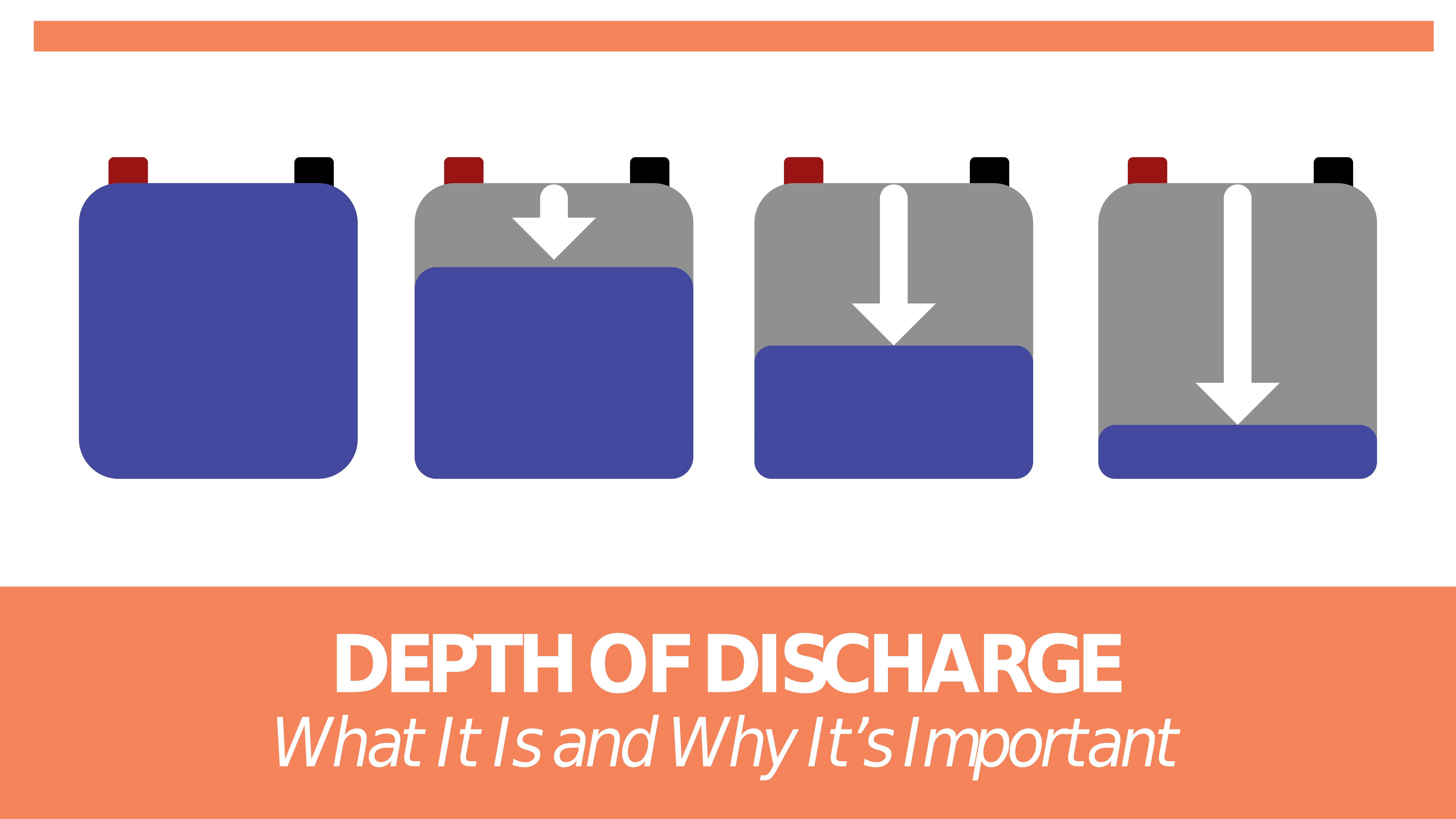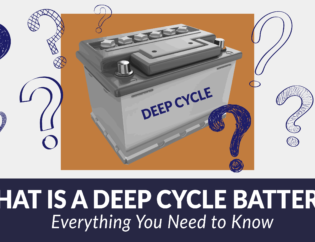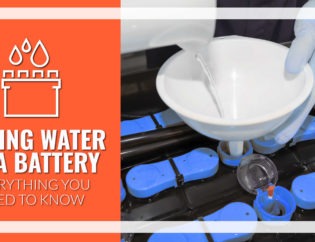
Depth of discharge (DoD) is one of the key aspects to consider when selecting batteries.
In this article, you’ll learn everything you need to know about depth of discharge, including:
What depth of discharge is
Why it’s important to know the depth of discharge
The depth of discharge of common batteries
And much more!
Let’s dive in!
You may have seen “DoD” listed on a battery label before and wondered: What does “DoD” stand for in batteries?
The answer is that it stands for “depth of discharge.”
But what does that mean?
Put simply, it means how much of a battery’s actual power can be used out of its total power capacity.
Depth of Discharge vs. Battery Capacity: What’s the Difference?
To understand exactly what depth of discharge means, we need to talk about battery capacity.
Battery capacity is the total energy supply that a battery has when it’s 100% charged.
But the thing is that you can’t usually use all that energy without damaging the battery.
So that’s where depth of discharge comes into play.
Depth of discharge is meant to tell battery users how much energy they can safely use from the battery without compromising its lifespan.
For example, let’s say you have a battery rated for 80% depth of discharge.
Now, what does 80% depth of discharge mean?
It means that you can only use 80% of your battery’s total rated capacity.
So if you have a 500 amp-hour capacity battery, you really only have 400 amp-hours to work with at 80% depth of discharge.
Depth of Discharge vs. State of Charge: What’s the Difference?
Battery state of charge (SoC) is exactly what it seems.
That is, it’s how much of a charge a battery has in any given condition.
So, a fully charged battery would have a 100% state of charge.
Often, it’s used in conjunction with depth of discharge.
Depth of discharge is simply the opposite of state of charge.
When that’s the case, state of charge is simply the inverse of depth of discharge.
Put another way, if a battery is at 100% state of charge, then its depth of discharge is 0%.
The opposite is also true.
If a battery is 100% discharged, its state of charge is 0%.
Depth of Discharge vs. Cycle Life: What’s the Difference?
A battery’s life cycle is the number of complete charge and discharge cycles it can go through before its performance begins to drop.
How Does Battery Discharge Affect Cycle Life?
Cycle life has an inverse relationship with depth of discharge.
In other words, the higher the battery’s depth of discharge and the more often it is discharged, the fewer cycle lives it will have.
For instance, a battery that’s continually discharged 80% will have fewer life cycles than if it were only discharged 20%.
This is why it’s generally not recommended to discharge a battery entirely.
Because doing so dramatically shortens its cycle life.
What Is the Cycle Life of a Battery?
Depending on the manufacturer, the type of battery, its depth of discharge, and the operating temperature, a battery’s cycle life can range from 500 to 8,000 cycles.
Assuming a 50% depth of discharge, the following are the common cycle lives for the most popular types of batteries:
A lead-acid battery cycle life is around 500 cycles
An AGM battery is also around 500 cycles
A gel battery has up to 1,000 cycles
A lithium-ion battery can achieve around 8,000 cycles
A battery with a higher depth of discharge has the advantage because it means you can use more of the battery’s energy before it needs a recharge.
As you can see above, that’s a key advantage of using lithium-ion batteries.
These batteries can tolerate a higher depth of discharge - often between 80% and 100% - without losing cycle life.
A higher depth of discharge means being able to use your battery longer before needing to recharge it.
Thus, you can get more usage out of lithium-ion batteries than other types.
Of course, a higher depth of discharge does have its downside.
As we covered in the previous section, a higher depth of discharge means you’ll have fewer life cycles.
So, it’s a matter of balancing your ability to use more of the battery daily against how long you want your battery to last.
What Is the Average Recommended Depth of Discharge in Batteries?
The recommended battery DoD varies by the type of battery and manufacturer.
Let’s cover the average depth of discharge of some common batteries.
What Is the Depth of Discharge of a Lead-Acid Battery?
The recommended depth of discharge for lead-acid batteries is 50%.
What Is the Recommended AGM Battery Depth of Discharge?
The recommended AGM battery depth of discharge is 80%.
What Is the Depth of Discharge for a Gel Battery?
The depth of discharge for a gel battery is 75%.
What Is the Depth of Discharge of a Lithium-Ion Battery?
In general, most modern lithium-ion batteries have a depth of discharge ranging from 80% to 100%.
Can You Fully Discharge a Lead-Acid Battery?
Never fully discharge a lead-acid deep cycle battery!
As we’ve said, the deeper you discharge the battery, the more its total cycle life reduces.
Most deep cycle batteries can handle only up to 50% depth of discharge, although some are built to handle up to 80% discharge.
Never fully discharge a lead-acid deep cycle battery!
If you frequently recharge your battery in a complete cycle, you can get just over 220 complete cycles if you drain it 80% each day.
But you could get up to 500 complete cycles if you only discharge the battery to 50%.
Is it Okay to Fully Discharge a Lithium-Ion Battery?
Answer: You should avoid doing so as much as possible.
Fully discharging a lithium-ion battery can potentially cause the individual cells to discharge at different states.
And when that happens, you can cause permanent damage to the battery.
The exception to this rule is when you rely on a power gauge fitted to the battery to give you the state of charge.

Because of something called “digital memory,” these gauges can get out of whack.
But by fully discharging the battery every 30 or so cycles, you can “reset” this digital memory and restore things back to normal.
What Happens If You Discharge More Than Your Battery’s Rated Depth of Discharge?
A few things will happen if you make a habit of over-discharging your battery:
You’ll wear your battery out quicker
The battery will take longer to charge
You’ll void the warranty
Exceeding the rated depth of discharge causes the plates inside the battery to deteriorate more quickly.
And this has a direct effect on the ability of the battery to continuously charge and discharge its current.
Furthermore, you’ll be out of luck by continually over-discharging your battery.
That’s because your manufacturer will not honor the warranty.
Wondering how is depth of discharge determined?
Let’s go through just that.
The battery discharge calculation is as follows:
Discharge current (in amps) x Length of time discharged (in minutes) ÷ 60 minutes ÷ Nominal capacity (in amp-hours) = Depth of discharge
For example, let’s say you have a battery with a nominal capacity of 500 amp-hours.
Then, you discharge a load of 250 amps for 20 minutes.
The calculation is:
250 amps x 20 minutes = 5,000
5,000 ÷ 60 minutes = 83.333 (this figure is your state of charge)
83.333 ÷ 500 amp-hours = 0.16667
That equates to a depth of discharge of 16.667%.
Conclusion
There you have it: Everything you need to know about battery depth of discharge.
Now we’d like to turn it over to you.
What have you learned about depth of discharge?
Can you explain the difference between depth of discharge and state of charge?
What about how depth of discharge affects cycle life?
Please share with us in the comments section!










Very well explained
Hi Michael, thank you for the compliment!
I fully agree.
Increasing depth of discharge reduces the number of charge cycles required for the same number of miles put on say, a golf cart. Those fewer cycles result in the battery attaining the same level of charge after those fewer cycles compared to a battery undergoing a lower level of discharge which requires more charge/discharge cycles.
Fantastic article!
Easy to follow!
Very relevant todaye, with all the solar and battery installations!
Hi Jacob, thank you for the kind comments! I’m glad you enjoyed this article!
Very good article.
For the last example, we can make it simpler, like:
250A*(20/60) h=83.333Ah,
DoD=83.333Ah/500Ah=0.16667=16.667%
Thank you for the article!
You’re welcome Johan!
Within reason, the depth of discharge (DOD) doesn’t matter as pertains to what charge the battery will hold after a given amount of miles driven, Example: your golf cart goes 30 miles per charge. If your DOD is 30% then after 9 miles driven you recharge it and then according to the charts after approximately 1950 cycles, the battery will only hold about a 50% charge. But if your DOD is 80% you only have to recharge every 24 miles or about 37% as often meaning you only recharge 731 times.
So…..if you go to the 30% DOD curve at 1950 cycles you see the battery is only holding 50% of its original charge. And if you go to the 80% DOD curve for 731 cycles you see that the battery also holds the same 50% charge. Bottom line: battery holding capacity is relatively insensitive to DOD. Higher DOD means fewer charges required and the battery recharges to about the same level after these charges v.s. a battery with a lower DOD which required far more charges.
You said it n the article that “As we’ve said, the deeper you discharge the battery, the more its total cycle life reduces.”
What you left out is that if you double the depth of discharge that you only need HALF the number of recharges. So while a deeper depth of discharge results in less cycles until the battery is useless, it only needs half the number of charge cycles as compared to a battery whose depth of discharge is half this amount. Bottom line: within reason (depth of discharges between 20 and 70%) depth of discharge has little to no effect.
Hi Jim,
Great points you make — there are definitely trade-offs between depth of discharge and cycle life!
A higher DoD can increase how much energy you can extracted per cycle, and this can reduce how many charge cycles are needed, which extends the overall useful life of the battery. However, deeper discharges can also cause increased sulfation and buildup on the battery plates, which can reduce the battery’s capacity over time and ultimately shorten its useful life.
I think the trick is trying to find a good balance between maximizing energy extraction and minimizing negative effects on the battery — while also keeping up on maintenance. Ultimately, we all want to get as much power for as long as possible out of our batteries!
Agree. Good article. And you’re right lower DOD in general, is better. Just wanted to point out that while greater DOD results in less charge cycles until the battery is useless, that same greater DOD results in fewer charges being required.
Comments are closed.